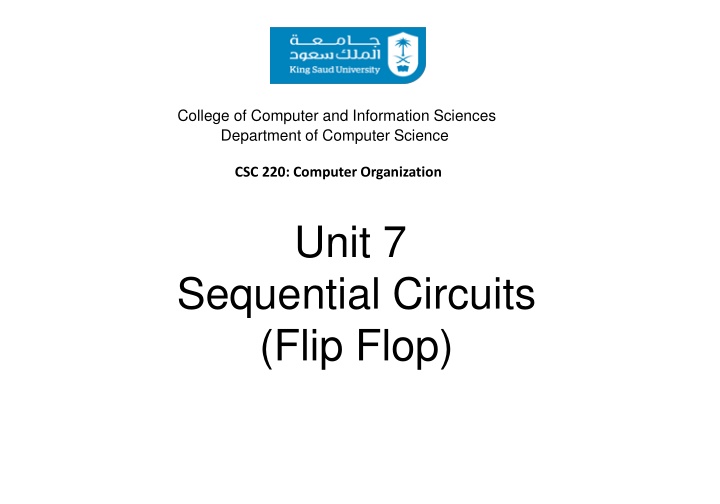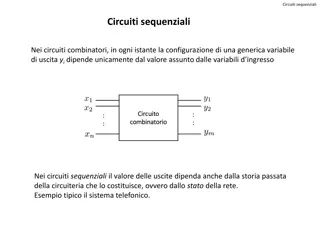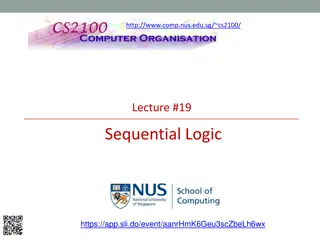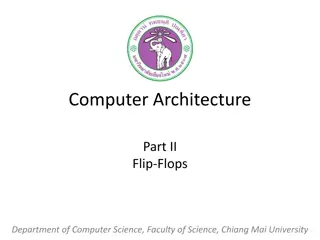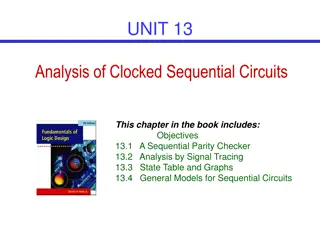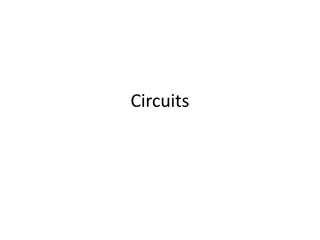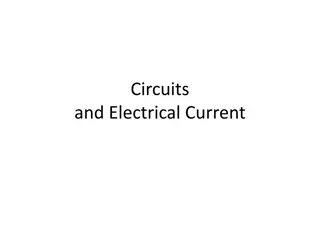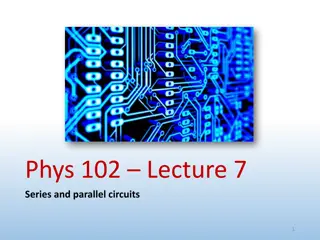Sequential Circuits in Computer Science
This content covers the basics of sequential circuits in computer science, focusing on SR latch, D latch, flip-flops, clock inputs, and more. Learn about the fundamental concepts and components essential for understanding computer organization.
Download Presentation

Please find below an Image/Link to download the presentation.
The content on the website is provided AS IS for your information and personal use only. It may not be sold, licensed, or shared on other websites without obtaining consent from the author.If you encounter any issues during the download, it is possible that the publisher has removed the file from their server.
You are allowed to download the files provided on this website for personal or commercial use, subject to the condition that they are used lawfully. All files are the property of their respective owners.
The content on the website is provided AS IS for your information and personal use only. It may not be sold, licensed, or shared on other websites without obtaining consent from the author.
E N D
Presentation Transcript
College of Computer and Information Sciences Department of Computer Science CSC 220: Computer Organization Unit 7 Sequential Circuits (Flip Flop)
Unit 7: Sequential Circuits Overview SR Latch S R Latch SR Latch with Control Input D Latch Clock and Synchronization Flip-flops Positive edge-triggered D Flip-flop JK &T Flip-flop Direct Inputs Chapter-4 M. Morris Mano, Charles R. Kime and Tom Martin, Logic and Computer Design Fundamentals, Global (5th) Edition, Pearson Education Limited, 2016. ISBN: 9781292096124
SR Latch The SR Latch, can be considered as one of the most basic sequential logic circuit possible. This simple circuit is basically a one-bit memory bistable device. It has two inputs, S: will SET the device (meaning the output Q = 1 ) R: will RESET the device (meaning the output Q = 0 ) Output Q is always complement of Q 4
S R Latch The S R Latch, is build with two cross-coupled NAND gate. S 0 1 1 0 R 1 0 1 0 Q 1 0 https://upload.wikimedia.org/wikipedia/commons/thumb/9/92/SR_Flip-flop_Diagram.svg/220px-SR_Flip-flop_Diagram.svg.png No Change ! 9
The output of the flip flop would always change on every pulse applied to this data input. To avoid this an additional input called the CLOCK or ENABLE input is used to isolate the data input from the flip flop s latching circuitry after the desired data has been stored. The effect is that D input condition is only copied to the output Q when the clock input is active. This then forms the basis of another sequential device called a D Flip Flop. 13
It can be seen from the frequency above, that by feeding back the output from Q to the input terminal D, the output pulses at Q have a frequency that are exactly ( /2 ) that of the input clock frequency, ( IN). In other words the circuit produces division as it now divides the input frequency by a factor of two (an octave) as Q = 1 once every two clock cycles. waveforms one half frequency 15
Both the S and the R inputs of the previous SR bistable have now been replaced by two inputs called the J and K inputs, respectively after its inventor Jack Kilby. Then this equates to: J = S and K = R.
Direct Inputs Flip-flops often provides special inputs PS, PR for setting and resetting them: Independent of clock input Initializes the flip-flop PS 1 1 1 1 0 1 0 PR 1 1 1 1 1 0 0 CK X X X J 0 0 1 1 X X X K 0 1 0 1 X X X Q(t+1) Q(t) 0 1 Q (t) 1 0 Undefined 20
D Flip Flops as Data Latches A data latch can be used as a device to hold or remember the data present on its data input, thereby acting a bit like a single bit memory device and IC s such as the TTL 74LS74 or the CMOS 4042 are available in Quad format exactly for this purpose. By connecting together four, 1-bit data latches so that all their clock inputs are connected together and are clocked at the same time, a simple 4-bit Data latch can be made as shown below. 21
